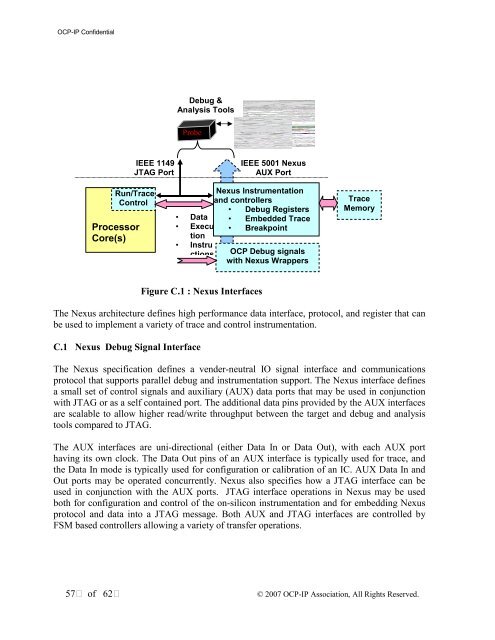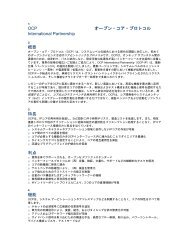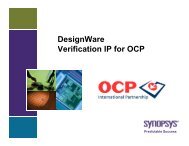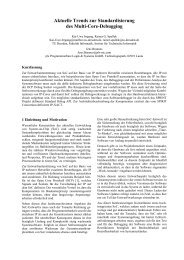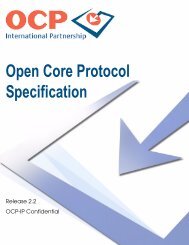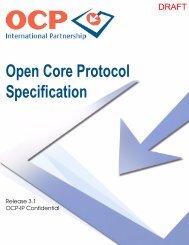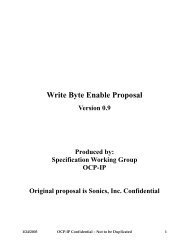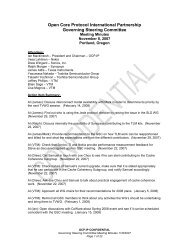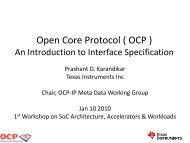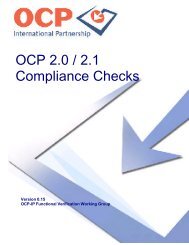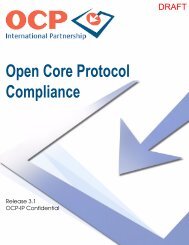Open Core Protocol Debug Interface Specification rev 1.0 - OCP-IP
Open Core Protocol Debug Interface Specification rev 1.0 - OCP-IP
Open Core Protocol Debug Interface Specification rev 1.0 - OCP-IP
You also want an ePaper? Increase the reach of your titles
YUMPU automatically turns print PDFs into web optimized ePapers that Google loves.
<strong>OCP</strong>-<strong>IP</strong> Confidential<br />
<strong>Debug</strong> &<br />
Analysis Tools<br />
Probe<br />
IEEE 1149<br />
JTAG Port<br />
IEEE 5001 Nexus<br />
AUX Port<br />
Run/Trace<br />
Control<br />
Processor<br />
<strong>Core</strong>(s)<br />
• Data<br />
• Execu<br />
tion<br />
• Instru<br />
ctions<br />
Nexus Instrumentation<br />
and controllers<br />
• <strong>Debug</strong> Registers<br />
• Embedded Trace<br />
• Breakpoint<br />
Triggers<br />
<strong>OCP</strong> <strong>Debug</strong> signals<br />
with Nexus Wrappers<br />
Trace<br />
Memory<br />
Figure C.1 : Nexus <strong>Interface</strong>s<br />
The Nexus architecture defines high performance data interface, protocol, and register that can<br />
be used to implement a variety of trace and control instrumentation.<br />
C.1 Nexus <strong>Debug</strong> Signal <strong>Interface</strong><br />
The Nexus specification defines a vender-neutral IO signal interface and communications<br />
protocol that supports parallel debug and instrumentation support. The Nexus interface defines<br />
a small set of control signals and auxiliary (AUX) data ports that may be used in conjunction<br />
with JTAG or as a self contained port. The additional data pins provided by the AUX interfaces<br />
are scalable to allow higher read/write throughput between the target and debug and analysis<br />
tools compared to JTAG.<br />
The AUX interfaces are uni-directional (either Data In or Data Out), with each AUX port<br />
having its own clock. The Data Out pins of an AUX interface is typically used for trace, and<br />
the Data In mode is typically used for configuration or calibration of an IC. AUX Data In and<br />
Out ports may be operated concurrently. Nexus also specifies how a JTAG interface can be<br />
used in conjunction with the AUX ports. JTAG interface operations in Nexus may be used<br />
both for configuration and control of the on-silicon instrumentation and for embedding Nexus<br />
protocol and data into a JTAG message. Both AUX and JTAG interfaces are controlled by<br />
FSM based controllers allowing a variety of transfer operations.<br />
57 of 62<br />
© 2007 <strong>OCP</strong>-<strong>IP</strong> Association, All Rights Reserved.


